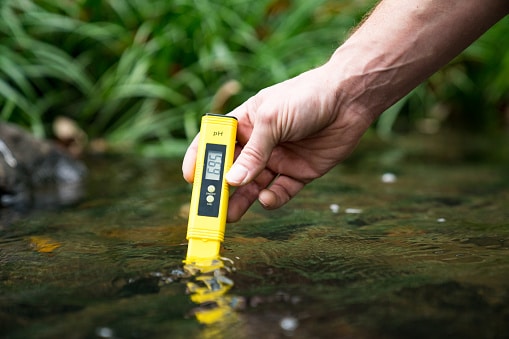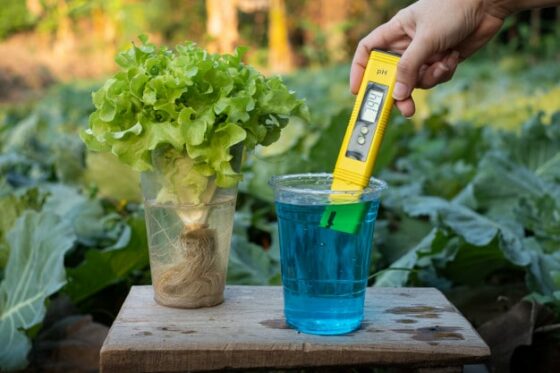I assume you’re here because you want to learn more about pH water meters to purchase the best one! In this article, we will put in a quick review of the best options in the market so you won’t have to.
Best water pH meters
Apera Instruments AI209 Value Series PH20 Waterproof pH Tester
This is quick, affordable, and of high quality. Its features allow for a reliable measurement of general water solutions like water treatments, pools, spas, horticulture, etc.

Pros
- Switchable between standard pH series, USA or NIST
- Adjustable reading between Fahrenheit and celsius
- Large and clear LCD screen display
- The smiley face appears if the reading is normal or stable
- Durable
- Water-resistant
Cons
- The 10 testing solution needed to measure saltwater tanks is not included in the kit.
- Flimsy pocket clip
VIVOSUN pH and TDS Meter Combo
This is a great pH water meter for aquariums and swimming pools. The reading goes from 0 to 14, a wider capability than others. On top of that, it will give you accurate readings quickly!
Pros
- Lock function to ensure exclusion of other factors that may influence the reading
- Portable
- Ergonomic design
Cons
- No calibration powder included
- Pricey
- Calibration changes from time to time, so adjustments before using it should be made if needed.
Apera Instruments AI311 Premium Series PH60 Waterproof pH Tester
For more professional pH measurements, this one is a great option. It houses an accurate sensor with a ±0.01 pH margin of error with a -2.00 to 4.00 pm and 32 to 122 degrees Fahrenheit range. All these without having to wait for so long.
This product has an IP67 water-resistant rating with an exterior that’s rugged enough to stay easy to handle in difficult conditions. In addition, the probe is replaceable, so there is no need to worry if you break it!
Pros
- Large and easy-to-read LCD
- 3 backlit colors: blue for measurement, green for calibration, and red for out-of-range readings
- The kit comes with 4 AAA batteries
- 2,000 runtime hours
- Replaceable probe sensor
Cons
- Replacements for calibration and storage solutions are pricey
- Water-resistant meter but not submergible
Bluelab PENPH pH Pen Fully Waterproof Pocket Teaser
This is a fully waterproof pH water meter that can last for longer than other units. Unfortunately, the device is sensitive, and calibration easily goes wrong, but the care guide can’t help you with anything!
Pros
- Great for everyday maintenance of gardens, pools, or aquariums
- Simple user interface
- Large and clear LCD
- Calibration will last for months
- Re-calibration only takes about a couple of minutes
- Reliable and high-quality performance
- Bluelab is a trusted hydroponic testing equipment brand!
Cons
- Cap is difficult to take off once left sitting on the meter for more than a day.
- The sensor may be damaged if kept wet
HM Digital PH-200 Waterproof Temperature PH Meter
A more affordable yet reliable option is this one from HM Digital. It is slick and insanely lightweight for the user’s comfort. Moreover, it is water-resistant and fares well even in harsh conditions. On top of that, it can also measure temperature. The kit comes with a storage solution and a single-use pH 7.0 buffer pack.
Pros
- Large and easy-to-read screen
- Automatic digital calibration button
- The data-hold feature allows a longer duration display of the last reading
- Auto-off function
Cons
- Requires storage in a buffer solution that evaporates and runs out quickly
- Frequent calibration is required
Buyer’s guide
Ease of use
While most pH meters come with user manuals that are easy to learn, some are still more user-friendly than others.
Reliability
The goal is to find a pH meter that provides repeatable and consistently accurate results. A margin of error of ±0.01 to ±0.02 is promising. Besides, the goal is to get accurate results, so it’s best to opt for devices that can offer you the most.
Versatility and functionality
Some models require calibration before first use, but that’s relatively quick. For example, some devices can measure temperature, electrical conductivity (EC), and total dispersed solids (TDS) to measure pH levels.
Precision
There are three pH testers: benchtop, portable handheld, and pen-style. Of the three, the benchtops are the most precise, but they are also pricier and less mobile.
Calibration
To get accurate results, calibration is critical. Thus, you must know when to calibrate your device. If the accuracy of the measurement is vital for you, you may calibrate it before use. Besides, it only takes a few minutes. If for general usage at home, you may calibrate weekly instead.
Temperature compensation
Temperature can affect your reading, so you should opt for devices with temperature compensation features to ensure that the different temperatures will not affect the measurement.
How to use a pH meter?

A pH meter has two main components: the meter and the digital element. Electricity principles are used to test water samples. Thus, an electrical circuit is created through a test solution. This is pretty easy to handle, and while most pH meters function the same way, you can never go wrong with reading the user manual!
How is pH measured?
The device measures the concentration of hydrogen ions to determine the pH level. The more positively-charged hydrogen ions there are, the more acidic the solution is and vice versa. The pH level of pure water is 7. Anything lower is acidic, and anything higher is basic. If you know how batteries work, this means that it’s producing more voltage.
Calibrating is an important process because a pH tester works like a voltmeter. They measure the solution’s electrical potential and compare it to an already identified value. The difference between these two is used to calculate the difference in pH.
Care guide
Calibration is vital, but if you do not take care of your device properly, it can still retire earlier than expected. Consult the instruction manual for specific means to care for your device. Generally speaking, here are great things to do to maintain your pH meter well:
- Read the instruction manual
- Calibrate frequently
- Handle with care
- Never store the sensor in distilled water
- Please don’t touch the sensor electrode or reference cell to keep the oil on your skin from being in contact with them, as it can cause damage.
- Store properly with cap upright and with storage solutions
- Get rid of air bubbles by lightly swirling the meter in storage solutions

Jay
Jay is a health and wellness enthusiast with expertise in water quality and nutrition. As a knowledgeable advocate for holistic well-being, Jay successfully manages Type 2 Diabetes through informed lifestyle choices. Committed to sharing reliable and authoritative insights, Jay combines firsthand experience with a passion for enhancing health."





